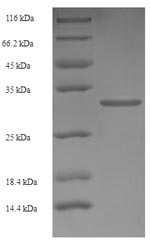The recombinant Human RARRES2 was expressed with the amino acid range of 21-157. The calculated molecular weight for this RARRES2 protein is 31.9 kDa. This protein is generated in a e.coli-based system. The N-terminal 6xHis-SUMO tag was fused into the coding gene segment of RARRES2, making it easier to detect and purify the RARRES2 recombinant protein in the later stages of expression and purification.
Human retinoic acid receptor responder protein 2 (RARRES2) acts as a chemoattractant, modulating immune responses and adipocyte function. RARRES2 is expressed in adipose tissue and the liver, playing a role in metabolic regulation and insulin sensitivity. Additionally, it participates in inflammation, angiogenesis, and cell differentiation. Its diverse functions implicate RARRES2 in metabolic disorders, cardiovascular diseases, and cancer. As a potential biomarker, it attracts attention in therapeutic research. Understanding the intricate roles of RARRES2 contributes to unraveling its implications in health and disease, spanning immunology, metabolism, and cancer biology.




